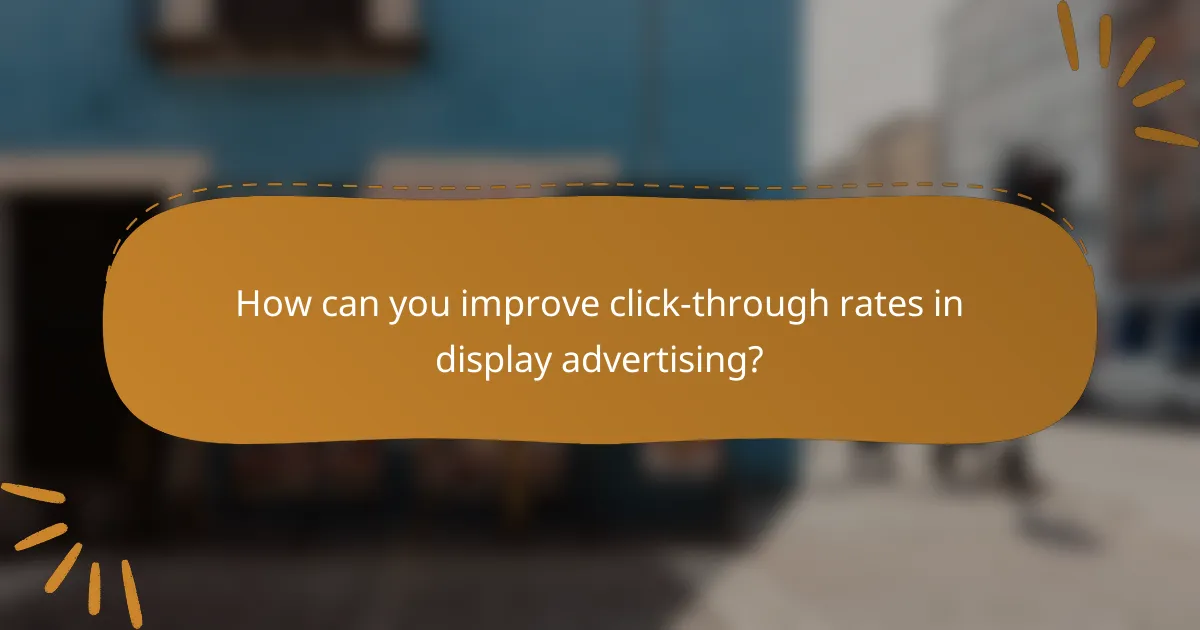Click-through rates (CTR) are a crucial metric in display advertising, reflecting the effectiveness of ad strategies in engaging target audiences. By analyzing current trends and seasonal insights, marketers can refine their approaches to maximize engagement, particularly as mobile usage and video content continue to rise. Understanding these dynamics enables advertisers to enhance their campaigns and drive higher traffic to their offerings.

How can you improve click-through rates in display advertising?
Improving click-through rates (CTR) in display advertising involves a combination of strategic ad copy, targeted demographics, and effective design. By focusing on these areas, advertisers can significantly enhance engagement and drive more traffic to their offerings.
Optimizing ad copy
Effective ad copy is concise, compelling, and tailored to resonate with the target audience. Use strong action verbs and clear calls to action (CTAs) to encourage clicks. For instance, phrases like “Get started today” or “Discover exclusive offers” can prompt immediate responses.
Consider A/B testing different headlines and descriptions to identify which variations yield the highest CTR. Regularly updating ad copy to reflect seasonal trends or current events can also keep the content fresh and relevant.
Targeting specific demographics
Identifying and targeting specific demographics can greatly enhance CTR. Utilize data analytics to understand your audience’s preferences, behaviors, and demographics, such as age, gender, and location. Tailoring ads to these groups ensures that the content is relevant and appealing.
For example, a campaign aimed at young adults may benefit from trendy language and visuals, while ads targeting older demographics might focus on reliability and value. Adjusting your targeting strategy based on performance metrics can lead to better engagement rates.
Utilizing A/B testing
A/B testing is a powerful method for optimizing display ads. By creating two versions of an ad and comparing their performance, you can determine which elements contribute to higher CTR. Test different images, headlines, and CTAs to see what resonates best with your audience.
Implement changes based on the results of these tests. For example, if a particular image significantly outperforms others, consider using it across multiple campaigns to maximize its effectiveness.
Enhancing visual design
The visual design of your ads plays a crucial role in attracting attention and encouraging clicks. Use high-quality images, bold colors, and clear layouts to make your ads stand out. Ensure that the design aligns with your brand identity while still being eye-catching.
Incorporate elements like contrast and whitespace to guide the viewer’s eye towards the CTA. Avoid cluttered designs that may confuse or overwhelm potential customers, as simplicity often leads to better engagement.
Implementing retargeting strategies
Retargeting strategies can significantly improve CTR by reminding potential customers of products they previously viewed. By displaying ads to users who have already interacted with your brand, you increase the chances of conversion.
Utilize platforms that allow for retargeting based on user behavior, such as Google Ads or Facebook Ads. Tailor your retargeted ads with special offers or new information to entice users to return and complete their purchase.

What are the current trends in click-through rates?
Current trends in click-through rates (CTR) indicate a shift towards higher engagement on mobile devices and the increasing effectiveness of video advertisements. Understanding these trends can help marketers optimize their strategies to improve overall performance.
Increased mobile engagement
Mobile engagement is significantly impacting click-through rates, with many users now accessing content primarily through smartphones. This shift has led to higher CTRs for mobile-optimized ads, often exceeding those of desktop ads by a notable margin.
To capitalize on this trend, ensure that your ads are designed for mobile viewing, with clear visuals and concise messaging. Testing different formats, such as responsive ads, can help identify what resonates best with your audience.
Impact of video ads
Video ads are increasingly driving higher click-through rates compared to static ads. Studies show that video content can boost CTRs by a substantial percentage, as it captures attention more effectively and encourages user interaction.
Incorporating video into your advertising strategy can be beneficial. Aim for short, engaging clips that convey your message quickly, ideally under 30 seconds, to maintain viewer interest and maximize clicks.
Seasonal variations
Click-through rates can fluctuate significantly with seasonal trends, often peaking during holidays or major events. For instance, CTRs typically rise during the holiday shopping season as consumers are more receptive to promotional content.
To leverage seasonal variations, plan your campaigns around key dates and tailor your messaging to align with consumer sentiment during those times. Monitoring past performance during similar seasons can provide insights for future strategies.

What seasonal insights affect click-through rates?
Seasonal insights significantly influence click-through rates (CTR) as consumer behavior shifts throughout the year. Understanding these trends can help marketers optimize their campaigns for better engagement and conversion during peak times.
Holiday shopping spikes
During the holiday season, click-through rates often see a marked increase as consumers actively seek deals and gifts. Campaigns that highlight promotions, discounts, and limited-time offers tend to perform better, especially in late November and December.
To capitalize on this trend, businesses should consider using targeted email marketing and social media ads that emphasize urgency and exclusivity. For instance, a 20% discount on popular items can significantly boost CTR compared to standard promotions.
Back-to-school campaigns
Back-to-school season typically generates a surge in click-through rates as parents and students prepare for the new academic year. This period usually spans late July through early September, with a focus on school supplies, clothing, and electronics.
Marketers should tailor their messaging to highlight essential items and bundle offers. For example, promoting a “buy one, get one free” deal on notebooks can attract attention and increase CTR during this busy shopping period.
Summer advertising trends
Summer often brings a dip in click-through rates as consumer priorities shift towards vacations and outdoor activities. However, certain sectors, like travel and leisure, can still see high engagement if campaigns are aligned with seasonal interests.
To enhance CTR during summer, brands should focus on promoting travel packages, outdoor gear, or summer sales events. Engaging visuals and compelling calls-to-action can help capture the attention of consumers looking to make the most of their summer experiences.

What metrics should you analyze for click-through rates?
To effectively analyze click-through rates (CTR), focus on key metrics such as the click-through rate percentage, conversion rate correlation, and engagement metrics. These metrics provide insights into user behavior and the effectiveness of your marketing strategies.
Click-through rate percentage
The click-through rate percentage is a critical metric that indicates the ratio of users who click on a link compared to the total number of users who view the content. A typical CTR can vary widely by industry, often ranging from 1% to 5%, with higher rates indicating more effective campaigns.
To calculate CTR, divide the number of clicks by the number of impressions and multiply by 100. For example, if your ad received 100 clicks from 10,000 impressions, your CTR would be 1%. Monitoring this percentage helps identify trends and optimize content for better performance.
Conversion rate correlation
Conversion rate correlation examines the relationship between click-through rates and the actual conversions that follow. A high CTR does not always guarantee high conversions; thus, it’s essential to analyze both metrics together to assess overall effectiveness.
For instance, if a campaign has a CTR of 4% but a conversion rate of only 0.5%, it may indicate issues with the landing page or the offer itself. Aim for a balanced approach where both metrics are optimized to ensure that clicks translate into meaningful actions.
Engagement metrics
Engagement metrics, such as time on page, bounce rate, and pages per session, provide additional context to CTR analysis. High engagement often correlates with better conversion rates, suggesting that users find the content relevant and compelling.
For example, if users click through but quickly leave the page (high bounce rate), it may signal that the content does not meet their expectations. Regularly reviewing these metrics can help refine your content strategy and improve both CTR and overall user satisfaction.

How do different industries compare in click-through rates?
Click-through rates (CTR) vary significantly across industries, influenced by factors like audience engagement, marketing strategies, and content relevance. Understanding these differences helps businesses tailor their campaigns for better performance.
Retail industry benchmarks
The retail industry typically sees click-through rates ranging from low single digits to the mid-teens, depending on the platform and type of campaign. Seasonal promotions, such as Black Friday or holiday sales, can boost these rates significantly.
For effective retail campaigns, focus on high-quality visuals and compelling calls to action. A/B testing different ad formats can also reveal which styles resonate best with your audience.
Common pitfalls include overloading ads with information or failing to optimize for mobile users. Ensure that your landing pages are fast and user-friendly to maximize conversions from clicks.
